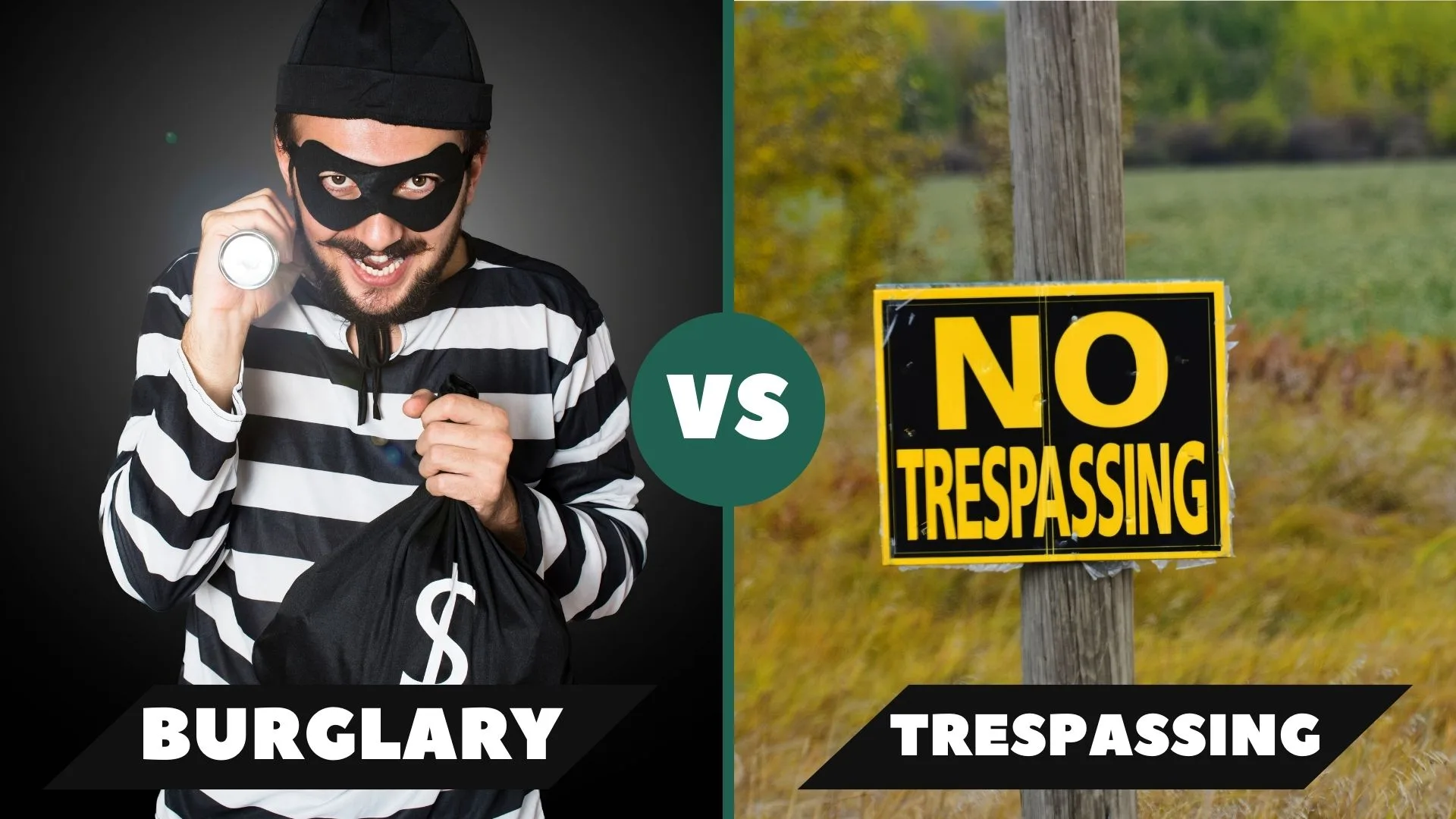Burglary VS Trespassing – 2 Distinct Crimes Seem Similar at First Glance

Beware!!!
What is the difference between a Burglary VS Trespassing?
In the realm of property crimes, two offenses that often come to mind are burglary and trespassing.
While Burglary VS Trespassing may seem similar at first glance, there are distinct differences between the two under the legal system in the United States.
Understanding these disparities is crucial to comprehend the seriousness of each offense and the potential legal consequences that individuals may face.
In this article, we will delve into the contrasting aspects of burglary and trespassing, shedding light on their definitions, elements, and penalties.
Here’s a comprehensive explanation of Burglary VS Trespassing each term:
Burglary
Burglary is a crime involving unlawful entry into a structure with the intent to commit a crime inside. The primary characteristic that sets burglary apart from other property crimes is the element of intent. To be charged with burglary, an individual must have the specific intent to commit a crime once inside the structure, such as theft, assault, or vandalism. It’s important to note that actual theft or harm doesn’t need to occur for a burglary charge to be established.
The severity of burglary charges can vary depending on the circumstances and the state’s laws. Generally, the presence of aggravating factors, such as possession of weapons or breaking into a dwelling while occupants are present, can elevate the offense to a higher degree, leading to more severe penalties. In the United States, burglary is typically classified as a felony, punishable by imprisonment, fines, restitution, and a permanent criminal record.
Trespassing
Trespassing, on the other hand, involves unauthorized entry onto someone else’s property without their permission. Unlike burglary, trespassing does not require the intent to commit a crime inside the premises. It is essential to understand that trespassing laws can vary from state to state, but there are generally two types of trespassing: criminal trespassing and civil trespassing.
Criminal trespassing is when an individual knowingly and unlawfully enters or remains on someone else’s property. It may also include entering areas where access is restricted or prohibited. The penalties for criminal trespassing can range from fines to potential imprisonment, depending on the jurisdiction and the circumstances surrounding the offense.
Civil trespassing, on the other hand, typically involves the violation of property rights but lacks the criminal intent associated with criminal trespassing. In civil cases, the property owner may seek monetary damages or injunctive relief through a civil lawsuit.
Topic: What is the difference between Burglary VS Robbery?
The main difference between burglary and trespassing lies in the nature of the crimes and the targets involved:
- Burglary involves the unlawful entry into a structure with the intent to commit a crime inside, while trespassing refers to unauthorized entry onto someone else’s property without necessarily intending to commit a crime.
- Burglary focuses on the specific intent to commit a crime once inside the structure, such as theft, assault, or vandalism. Trespassing, on the other hand, lacks the criminal intent associated with burglary.
- In burglary, the target is a structure or building, whereas in trespassing, the target is someone else’s property, which can include land, houses, or other types of premises.
- The severity of penalties differs significantly between burglary and trespassing. Burglary is generally considered a more serious offense and is often classified as a felony, potentially resulting in imprisonment. Trespassing, on the other hand, is typically a misdemeanor offense with less severe penalties.
- While both offenses involve unauthorized entry onto someone else’s property, the intent to commit a crime sets burglary apart from trespassing, making it a more serious legal offense.
Topic: What is the difference between Burglary VS Theft?
Burglary vs Trespassing Sentence
Burglary carries severe penalties, including imprisonment, substantial fines, restitution, and a permanent criminal record. The sentence depends on factors like aggravating circumstances, stolen property value, and harm caused. It is typically a felony, resulting in lengthy prison terms for violent or repeat offenses.
Trespassing is a lesser offense but still has legal consequences. Penalties vary by jurisdiction and circumstances, typically resulting in fines, community service, probation, or short-term imprisonment. Factors such as prior convictions, intent, harm caused, and restricted area violations can impact the severity of the sentence. Consulting local laws and legal professionals is essential to understanding specific trespassing consequences.
Summarize
While burglary and trespassing share the element of unauthorized entry onto someone else’s property, they differ significantly in terms of intent and potential harm.
Burglary involves the intent to commit a crime inside a structure, while trespassing focuses on the unauthorized presence on someone’s property without the intent to commit a crime.
Understanding the distinctions between these two offenses is crucial to appreciate the gravity of each and the potential legal ramifications that may follow.
It is advisable to consult local laws and legal professionals to gain a comprehensive understanding of burglary and trespassing regulations specific to your jurisdiction.
Trespassing VS Criminal Trespassing?
Trespassing refers to unauthorized entry onto someone else’s property, while criminal trespassing involves knowingly and unlawfully entering or remaining on someone else’s property.
How much is trespassing fine?
The amount of a trespassing fine can vary depending on the jurisdiction and specific circumstances of the case.





